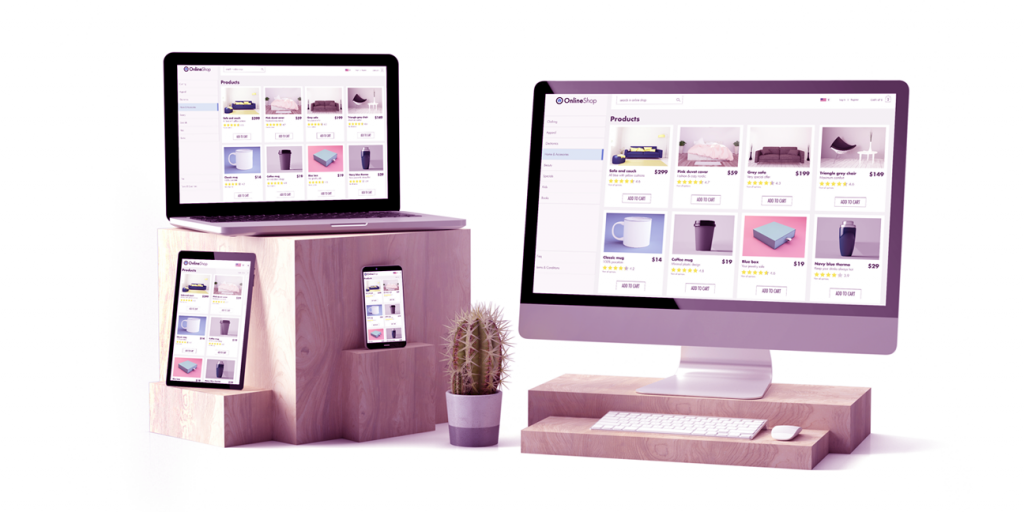Table of contents
One of the most important components of an online store’s success is building its organic visibility, which translates into traffic, which translates into subsequent sales of our products.
E-commerce marketing strategies should always include SEO activities because, in the long term (if carried out correctly), they provide an extremely attractive ratio of the costs incurred to the generated sales.

So how do you improve the visibility of your online store? Here are 13 tips, for beginners:
1. Consider SEO already in the stage of building your online store
Google gives a number of very specific guidelines that a website must meet when appearing in high positions in search results, and it is against these that the algorithm checks websites when determining position ranking. So it’s no secret that only a well-optimized site has a chance to rank high for popular phrases.
Practice shows that the popular saying „prevention is better than cure” is also worth transferring to the plane of building new online stores. Optimization under Google’s guidelines, already existing e-commerce is, of course, as possible and no less effective, but definitely more costly.
P>
Therefore, when preparing the design of a new online store, the team responsible for it should ensure that, in addition to web developers, graphic designers, and UX specialists, there is also an SEO specialist. He will indicate suggestions on how to take into account many of Google’s requirements already at the initial stage of work so that the already finished site does not have to undergo later rebuilding, which could have been prevented.
2. Simplicity is key when building website structure and URLs
The simpler the site structure we adopt, the better it will be in terms of UX, i.e. user experience, but also in terms of SEO in terms of indexing the content by search engine robots.
We need to plan the structure of our site so that the user (and the search engine robot) can go to any place on it and return to the home page in a minimum number of steps. Thus, it is important to plan the links within the site itself and the category tree and its presentation.

If we plan the site’s category structure too complicated, requiring many steps to go from the home page to the product and its purchase or to navigate between products, we will very quickly lose user engagement, and the user will simply leave our site without completing the transaction.
The same will work for a search engine robot – if the site’s internal link structure is too complicated and illogical, it may not reach all the pages we would like it to index in the search results.
The simplest structure of a page is, of course, the scheme:
MAIN CATEGORY -> SUBCategory -> PRODUCT
Of course, with this structure, it is easy to build simple and friendly URLs that reflect it, such as domain.com/category/subcategory/product.
The situation starts to get a bit more complicated when we have many products that can be divided into more subcategories:
MAIN CATEGORY -> SUBCategory 1 -> SUBCategory 2 -> SUBCategory 3 -> PRODUCT
The URL in this case, may prove to be far too long to be considered friendly, especially if the names of our subcategories consist of many characters. The solution here may be to forgo reflecting the structure of the site in addresses in a 1:1 form.
This is how the structure is designed for one of the best-indexed online clothing stores in Poland—Zalando. Its category tree structure is quite deep, sometimes having up to four hollows, but it is reflected in the URL using appropriate keywords, and the user can easily move to the higher-level categories using the menu and very well-constructed breadcrumbs.
The site’s structure is also very deep.
For example, the subcategory of summer dresses is included in the structure as follows:

Since the product is only in the 5th cavity of the structure, in this case, the address directly reflecting this structure would be extremely long and would look roughly like this: domain.com/women/clothes/dresses/summer-dress/year-old-dress/year-old-dress-with-red-flowers
This kind of address is unfriendly to both the user and the search engine robot, so to avoid this Zalando uses shortened URLs that contain keywords to indicate a specific category, instead of reflecting the entire path:

For large online stores, it is worth embracing just the above URL-building strategy, as it is both user-friendly and friendly to page indexing by robots.
3. Do-expansive-analysis-of-keywords-and-user-intentions-before-starting-actions
To build optimized content for your online store, whether it’s product description content or blog posts, we first need to do keyword analysis with user intent in mind.
Basically, keywords fall into 4 categories according to the intention with which they are typed into the search engine by users:
- Commercial – a user enters a given phrase into the search engine with the intention of buying however they may not yet be ready for it, e.g. dryer washing machine comparison, dryer washing machine price, dryer washing machines reviews
- Navigational – such keywords are typed by users into the search engine with the intention of reaching a sub-page/product on a specific site; they are important in that they indicate that the user is already familiar with the brand and has most likely encountered its site before, e.g. dry washing machine media market price, washing machine with drying function media markt warszawa targówek,
- Informational – these are phrases typed in by users who want to learn as much as possible about a particular topic, e.g. is it better to buy a washer-dryer or a washer and dryer
- Transactional – keywords showing a strong purchase intention that can lead immediately to a transaction, e.g. SAMSUNG WD70TA046BH washer-dryer with delivery tomorrow
So, using the phrase „washer-dryer,” we can see that users can type different variants of it into the search engine depending on their intentions. Well-constructed content for an online store should include a variety of phrases with different intentions so as to have something to offer the user at each stage of the buying process. This is especially important if our store sells higher-value products, which are usually not subject to impulse purchases and require a slightly longer decision-making process.
Building a list of phrases to include in content, we should start by analyzing our product list in terms of what their buying process might look like, then assigning words with specific intent to each of its stages (after first checking their search potentials), and then choosing the types of content in which these keywords should appear.
Continuing with the example of a washer-dryer, the process of buying it can go as follows, and to each stage, we can assign keywords to it:
- My washing machine broke down, so I need to make a new purchase. However, it may be worth buying one with a drying function—at this stage, the user enters information phrases into the search engine.
- I have decided that I want to buy some kind of washer-dryer – at this stage the user enters commercial phrases to choose the most optimal product for himself
- In an earlier search, I saw a cheap Samsung washer-dryer, on the Media Markt website – the user enters navigation phrases
- I decided to buy a particular model of Samsung washer-dryer – user enters transactional phrases
Phrases assigned to the first stage of the purchasing process, i.e. information phrases, should be included in the supplementary content for our products in blog articles, which can address more broadly the most common doubts about the purchase of particular groups of products.
The phrases assigned to the second stage of the shopping process should be included in the content on the subpages of the product categories from which a given user may want to choose. It would be worthwhile for him to get right there with their help so that he can compare them for himself.
They should also be used as a tool for the user to compare products.
Phrases assigned to stage 3 of the shopping process are usually branded phrases that do not require additional SEO support; they appear naturally in the results. However, to associate the brand with the product in the search results, it is worth including the brand name in the page title together with the product name.
The brand name should be included in the title of the page along with the product name.
Phrases assigned to the 4th stage, i.e., strictly transactional, should be included in the description of the product so that a search engine user can easily access it directly.
4. Make-accurate-optimization-subpages-of-products-and-categories
Optimization of product subpages is extremely important if you want to appear high in the search engine for transactional keywords. And these, as we know, are characterized by the highest conversion rate.

Elements to consider when optimizing product pages:
- a friendly, short product URL, including the most important keyword for it
- posting the product in the structure in such a way that it can be reached from anywhere on the site
- description of the product, with its technical specifications, included in the content selected in an earlier analysis of the most frequently searched keywords by users (also included in the H-headers) and CTA
- photographs of the product with the alt attribute supplemented with the most important keywords
- product ratings and reviews, which will add credibility and further encourage undecided users to make a purchase
No less important are the sub-pages of product categories and sub-categories:
- these, too, must have, in addition to just a list of products, their own individual content, containing keywords with appropriate intent
- Adequately structured H-headers, the content of which must also include keywords
- appropriately constructed breadcrumbs and category and subcategory list menus so that the user can freely navigate through the site.
5. Avoid duplication of content – publish only original content
Originality of content is now one of the most important (next to technical optimization) ranking factors that Google takes into account. However, maintaining it when running an online store is not all that easy. Actions for maintaining content originality in an online store we should consider two cases:
- We are the manufacturer of the products we sell – in this case, the matter is simple: if we are also one distributor, we simply create original descriptions of our products and publish them in our online store. Unfortunately, the matter begins to get a bit complicated if our products, in addition to our store, also appear in other places on the web – on Allegro or other sellers. In this case, it is best to have two variants of our product descriptions – optimized for the adopted SEO strategy, which we will publish on our own site, and the second, which will go to other distributors.
- We are only a distributor of products from different manufacturers. In this case, to maintain the originality of the content, we need to create our own original product descriptions based on the information and descriptions we receive from the manufacturers, which we then adapt to our SEO strategy.
6. Avoid duplication of subpages
Selling many types of one product can easily lead to the presence of many very similar subpages on the site, the presence of which could be avoided.
This happens most often if we sell products with different variants. In this case, if we are dealing with the same product at the same price, differing only in one detail, which may be, for example, its colour, it is not worth multiplying subpages and adding separate products, for example, for one blouse in 7 colour variants. Only the product itself gives the user the possibility to choose the colour variant.
This is beneficial for three reasons:
- fewer subpages require us to create fewer descriptions, and in the cited case, it is hard to have an original description of products that differ so little from each other.
- Showing the user, within one product card, all possible variants of the product, can increase the chance of purchase – if the user is not fully convinced of the product in a particular variant, and immediately sees other options
- Smaller websites index faster, so we have a faster chance to achieve positions in organic search results
7. Use schema.org tags
Schema.org tags are a group of specific HTML tags that provide additional information about the content of a given web page. Using schema.org also allows you to display enhanced search results (rich snippets) for a given page, which are very important in terms of keyword conversions. A more expanded Google result is more likely to encourage visitors to a given website.
There are many types of rich snippets, the most popular for online stores are:
- Product extensions – a search result using them can include, for example, the price, images or current availability of a product on a given website
- Rating extensions – allow you to see the rating of a particular product or service already at the stage of browsing search results
- Facebook FAQ extension in search results – allows the FAQ posted on the page to appear under the organic search result of a given subpage
- Video extensions – within the search result, in addition to the title and description, a video can also appear
Inserted on schema.org, you can test within the official Google tool: https://developers.google.com/search/docs/appearance/structured-data?hl=pl
8. Develop-content-page—not-only-product-descriptions
An important part of developing the content of the site, in addition to creating original product descriptions, of course, is to maintain a content section in the form of a blog, news or advice base.
We want to attract users typing in search engine keywords with informational intent to such expanded content. By answering users’ questions and doubts on a topic related to the type of products we offer, we first put ourselves in the role of an expert, and this increases trust in our store. Second, a user who has received an answer to a question bothering him is more likely to make a purchase.
The user who has received an answer to a question bothering him is more likely to make a purchase.
In this type of strictly informational content, we should contextually „smuggle” our products so that the user has a chance to get acquainted with them and in the future buy them.
Developing such content should be done regularly, according to a pre-prepared content plan. This plan was created based on an analysis of user searches on a given topic and an analysis of the competition’s content.
9. Don’t-forget-how-major-importance-your-page-speed-and-Core-Web-Vitals-results
Several years ago, to make it easier for website owners and search engine robots alike to assess a website’s health, Google introduced the concept of Core Web Vitals, or Core Web Indicators. These must be scored at a certain level if a site wants to appear high in organic search results.

The most important Core Web Vitals are:
- LCP – Largest Contentful Paint – the time it takes for the largest page element to load
- FID – First Input Delay – the time it takes to interact with the page for the first time
- CLS – Cumulative Layout Shift – unexpected shifts in the page layout
- FCP – First Contentful Paint – time of rendering the first complete element
Of course, these are not the only CWVs. We can check the others and their values with the dedicated Page Speed Insights tool prepared by Google. This tool allows us to check the rating of each individual CWV and to know the total rating of our website on a 100-degree scale. Within this tool, Google also presents very specific tips (with examples) of the elements we should fix to achieve the best possible score.
Considering the above, it’s not surprising that the CWV score is taken into account when Google’s search engine algorithm evaluates a website – after all, we’ve been given a free powerful tool to boost that score.
10. Let-robots-easily-index-your-website-don’t-forget-to-add-sitemap.xml-file

The purpose of constructing and posting a sitemap.xml file on a website is to make it easier for search engine robots to index our website, indicate to them the changes that occur on it, and understand its structure more accurately.
The sitemap.xml file can be created manually or using one of the many existing solutions on the market dedicated to this purpose. The finished sitemap.xml file should be submitted through the Google Search Console tool in the panel section created for this purpose.
The sitemap.xml file should be submitted through the Google Search Console tool in the panel section created for this purpose.
11. Don’t forget about link-building
In addition to content and technical optimization, building an online store’s authority and domain rating through link building is also an important aspect. Link acquisition should be done thoughtfully to make the best use of the budget you have.
We should post our sponsored articles with a link on high-quality sites thematically related to our online store. It’s also worthwhile to conduct PR activities, which can be another source of links.
Also, let’s not forget to publish content on social media. Even though links from them do not directly convey SEO power, they are still an important source of additional traffic and help build our site’s Google search presence.
12. Social media links
Today, social media plays a huge role in marketing products. Thanks to the appearance on the accounts of popular influencers, a product can become viral, stimulating not only its sales but also the creation of awareness of a brand’s existence, which then translates into organic brand traffic.
To facilitate this whole process, we should include quick links to our social media profiles on the site and give the possibility to easily share content from the site, through, for example, plug-ins dedicated to our store’s CMS, which easily allow us to share an attractive-looking link to our product.
13. On-going-monitor-site-status-and-messages-in-Google Search Console
Optimizing an online store is never a finite process. As the content and product base grows, elements such as page load time, for example, may change, and due to the increase in volume, the page may become longer. Technical errors, such as server errors, sub-pages not working, etc., may appear. The Google search engine algorithm itself may also change, and it will be necessary to adjust the site for these changes.
The most important thing in this aspect is to regularly monitor the information appearing in Google Search Console, as this is the only place where Google communicates with us about our site. It points out any indexing errors that appear and indicates improvements such as Core Web Vitals.
The Core Web Vitals score itself, too, is worth checking regularly. Its significant deterioration indicates that our site had some major technical problems.
If you want to improve the visibility of your online store, feel free to contact us!
Was the article helpful?
Rate our article, it means a lot to us!
Let's talk!
She has 11 years of professional experience, she started her career at the Emarketing Experts agency as a junior SEO specialist. In addition to website positioning, she was responsible for conducting 360° marketing projects as an Account Manager at They.pl. She worked for companies from the financial sector (Bank Millennium, Bank Meritum, Finai S.A.) and e-commerce (e.g. Black Red White, Autoland, Mumla). At Up&More, he is responsible for, among others, SEO projects for Panek Car Sharing, Amerigas, Interparking, H+H and Autoplaza.